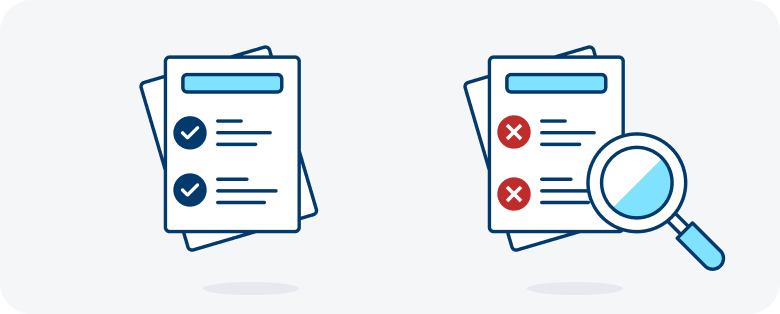11 min read
How to Write a Lease Agreement in 10 Steps
If you came here wondering how to write a lease agreement, look no further. Creating iron-clad rental contracts is essential for protecting the rights...

If you came here wondering how to write a lease agreement, look no further.
Creating iron-clad rental contracts is essential for protecting the rights of both landlords and tenants. These legally binding agreements are too important to get wrong.
To assist you, we’ll walk you through the tried-and-true 10-step process for creating a sound lease agreement yourself. We’ll also tell you how to use a simple template to generate a state-specific rental contract with just a few clicks and keyboard taps.
Landlords, let’s dive in.
Between including mandatory landlord disclosures, defining rental terms, resolving potential disputes, and more, a lot is riding on your next lease agreement.
Using a customizable state-specific lease template to generate your next contract could save you time, stress, and potential legal hassles down the road.
So, before attempting to create a lease agreement of your own (or hiring an expensive lawyer to do so on your behalf), consider using one of TurboTenant’s legally-reviewed lease agreement templates instead.
Doing so will ensure that your next rental contract checks all the boxes and stands up to the letter of the law.
And it should only take you around 15 minutes.
But if you’d prefer to take a stab at it yourself, we’re happy to help. Here are 10 simple steps for writing your next lease agreement.
Note: This article is for educational purposes. TurboTenant does not provide legal advice.

Landlords must include essential identification details in a rental agreement describing the parties entering the contract together, the specifics of the rental property, and the lease terms.
Landlord and tenant details: Include the legal names, addresses, and contact details of the landlord, tenant, and property managers to identify the parties.
Property information: Clearly and accurately describe the rental property, including:
Lease term: The lease term should be explicitly stated, including its duration, lease type (fixed-term or month-to-month agreement), and the exact start and end dates of the tenancy.
Landlords nationwide must include specific legally required disclosures with their lease agreements to ensure tenants understand all mandatory information before signing. These disclosures cover a range of topics, from lead-based paint and bed bug history to illicit drug use and other illegal activities.
Because they vary widely by state, hammering down an accurate set of disclosures while constructing your lease is key. Fun fact: did you know that Arkansas only has three required landlord disclosures, whereas California has 21?
Landlords who fail to include state-specific disclosures in their lease agreements could be fined, sued by tenants, and even charged with criminal violations if they commit severe violations.
Landlords should explicitly state rent and payment terms within all rental agreements. To do so, clearly outline the tenant’s monthly rent amount, due date, accepted payment methods, and the late fee policy.
Rent amount: Specify the exact monthly rent amount and the currency to pay it.
Due date and payment: State the exact day the rent is due each month. If you offer a grace period for late rent payments, specify how long it lasts (and ensure your policy complies with state laws). Beware that in some states, state law mandates a specific grace period, and landlords cannot apply late fees to rent payments made within that period.
Payment methods: Outline all acceptable payment methods for tenants to pay rent, which might include:
If you use a rent collection platform, specify it in the lease and provide tenants with instructions on how to use it.
Late fees: If you charge late fees, state the amount and when the fee applies. Ensure that any late fee policy you enact complies with state and local laws.
Security deposit: State the security deposit amount and where the landlord will keep it. Also, detail the circumstances in which the landlord can use the deposit, like:
Other fees: On top of rent, late fees, and the security deposit, list any other applicable fees, including:

In clear terms, describe how landlords and tenants will handle maintenance responsibilities by stating which party is responsible for specific upkeep, repairs, and essential services.
Tenant’s responsibilities: Outline the tenant’s obligations to maintain the property. These duties often include:
Landlord’s responsibilities: Outline the landlord’s obligations to maintain the property and provide essential services. These duties often include:
Maintenance requests: Establish a clear protocol for tenants to report maintenance issues or request repairs from landlords. This section should include:
In this portion of your lease, clearly outline your rental unit’s rules and restrictions to set clear expectations between landlord and tenant.
Pets: Specify whether pets are allowed within the rental property, and if so, outline any restrictions on breed, size, or type. If you allow pets, explain any associated fees that apply, like pet deposits or rent.
Smoking/vaping policy: Explain whether smoking and/or vaping are allowed inside the rental unit, on balconies or patios, or in the property’s common areas. If you have a no-smoking or no-vaping policy, state it within the lease.
Noise and behavior: Outline tenant expectations regarding noise levels and behavior. Detail a rental unit’s quiet hours (if they exist) and emphasize the importance of allowing one’s neighbors to experience uninterrupted peaceful enjoyment of their dwellings.
Property alterations: Clearly state whether or not the landlord permits tenants to make alterations or improvements to the rental unit. Typical property alterations include:
To avoid confusion, clarify which utilities the landlord includes in rent and which the tenant must pay directly to the provider.
Included utilities: List any utilities the landlord includes in the rent payment (e.g., water, sewer, trash, electricity, gas).
Tenant-paid utilities: Specify any utilities the tenant is responsible for paying directly to the provider (e.g., internet, cable, phone).

Whenever a landlord or tenant wants to end or renew a lease, the agreement should instruct them on how to do so. The following section of your lease should provide all relevant state-specific details about ending or extending a rental contract.
Ending the lease: Clearly explain the process for ending the lease agreement once it has reached its end date. Specify the required notice period, if one exists, and how to deliver the notice to the other party.
Early termination: Outline the circumstances in which the landlord or tenant can terminate the agreement before its agreed-upon end date. Common reasons include:
Renewal terms: Clearly state whether the lease automatically renews at the end of its initial term and, if so, whether it converts to a month-to-month tenancy or requires a new lease agreement.
Fixed-term vs. month-to-month considerations: Termination and renewal protocols often differ between fixed-term and month-to-month leases. Review your state’s landlord-tenant laws for guidance on local renewal and termination procedures.
Landlords should include essential legal clauses that protect both parties in all rental contracts, whether addressing eviction protocols, subletting rules, insurance requirements, or dispute resolution procedures.
Eviction: Outline the state’s grounds for eviction, like non-payment of rent, uncured lease violations, or illegal activities on the premises. Detail the state-specific eviction process from start to finish.
Subletting: Inform tenants whether subletting to a third party is permitted. If so, outline subletting protocols, like screening prospective tenants, drafting a new sublease agreement, and more.
Renter’s insurance: Specify whether tenants must purchase renter’s insurance and state the minimum coverage amounts. Consider requiring the landlord to be listed as an “interested party” or “additional insured” on the policy.
Dispute resolution: Outline a dispute resolution process between landlords and tenants, such as arbitration or mediation, before either party should pursue legal action.
Governing law: To ensure your rental contract complies with applicable laws, declare which state and local laws govern the agreement. Doing so will help ensure the lease is enforceable in your jurisdiction.
Severability: Include a severability clause stating that if one provision within the lease is (or becomes) invalid, the remaining provisions remain valid.
Before you and your tenant sign a lease agreement, ensure it is clear, concise, and legally sound. Use non-ambiguous language and always comply with your state’s landlord-tenant laws to help prevent potential legal issues.
Clarity: Use straightforward language throughout the rental contract and avoid complex legal terms that could confuse tenants.
Compliance: Ensure your contract complies with federal, state, and local laws. Pay close attention to laws regulating security deposits, required landlord disclosures, notice requirements, eviction protocols, fair housing laws, and more.
Legal review: When in doubt, hire an attorney specializing in landlord-tenant law to review your lease agreement. They will analyze your contract to ensure it is legally enforceable, complies with federal and local laws, and protects your rights.
Lease templates: Consider using a legally reviewed lease template from a trusted brand like TurboTenant to generate a customizable rental contract. Legal professionals frequently update these templates to include up-to-date legislation.

Signing a lease ensures the agreement is correctly executed and legally enforceable. To finalize your rental contract, include designated signature sections, abide by applicable witness or notarization requirements, and provide copies of the signed lease to both landlord and tenant.
Signatures: Throughout the lease, include clearly marked signature blocks for the landlord and tenant to sign and date. For clarity, also include sections for printed names below the signatures.
Witness or notarization: While not required by most states, certain states (Connecticut, Ohio, and Washington) require a witness or notary to sign a lease to be considered valid. Refer to your local laws for specific witness or notarization regulations in your area.
Copies for both parties: State that both the landlord and tenant will receive a signed copy of the lease agreement after signing, and do your best to provide copies immediately thereafter.
A well-crafted lease agreement encourages a healthy landlord-tenant relationship by outlining expectations and responsibilities and protecting the rights and interests of both parties.
If you’ve decided to roll up your sleeves and use this step-by-step guide to create a lease agreement all on your own, we have three words for you:
Best of luck.
And if you’ve decided to let property management software do the heavy lifting and generate a legally-reviewed lease agreement on your behalf, we have two words for you:
Well done.
To generate your next rental contract, use TurboTenant’s customizable lease agreement template to complete the job in 15 minutes or less. A few of its helpful features include:
But wait, there’s more!
In addition to creating lease agreements, our all-in-one software enables landlords to manage all other aspects of their properties, including:
Sign up for a free TurboTenant account today to see how we can help revolutionize your property management operation.
11 min read
If you came here wondering how to write a lease agreement, look no further. Creating iron-clad rental contracts is essential for protecting the rights...
10 min read
Between the risks of running a business, a volatile and ever-changing real estate market, and the sometimes fickle attitudes of the renting...
6 min read
Maybe you’ve been here before: You’re juggling a mess of applications, fielding phone calls for property showings, and wondering where that screening...
Join the 700,000+ independent landlords who rely on TurboTenant to create welcoming rental experiences.
No tricks or trials to worry about. So what’s the harm? Try it today!
TurboTenant, Inc., © 2025
Created in Sunny Colorado